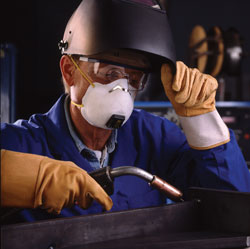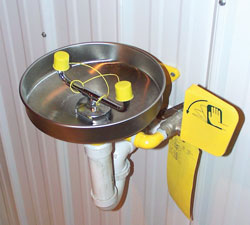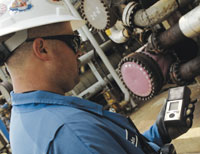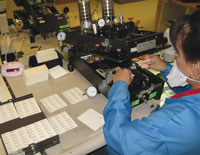
May 2009
- BREAKTHROUGH STRATEGIES: Two Ultimate Questions
- IH PRODUCT FOCUS: A Week in the Life of a Gas Monitor
- SHOWERS & EYEWASH: Help Is Out There
- WORKER'S COMP: Keep Your Supervisors In the Game
- HEAT STRESS: Accurate Temperature Readings Are Vital
Click here to subscribe.
Features

On Feb. 23, 2009, a federal appeals court resolved the final challenges to the Occupational Safety and Health Administration’s Hexavalent Chromium (CrVI) Standard that was promulgated in February 2006. The last challenge argued to lower the permissible exposure limit (PEL) to 1 μg/m3 from 5 μg/m3. This appeal was denied, and OSHA’s PEL was upheld by the court.

By Becca Kandler
No one can predict when a chemical splash will occur. But we can plan for the possibility, put in place preventive and protective measures, and prepare for a quick emergency response.

By Carla Saavedra
The string of bad news coming out of New York City in the past year—from Eliot Spitzer's sockladen rendezvous to the domino effect of a failing Bear Stearns to Bernard Madoff and his minions of mini-Madoffs— may make the megalopolis seem more like the notorious Gotham City of the '20s and '30s than the gentrified clean streets of Sex and the City. However, despite the overnight return to its grainy, corrupt past, the city may be one of the only places that can get the nation out of the recession. Companies are tightening their purse strings, cutting everything from office supplies to their workforce, and employees are going to work fearing they may be next on the chopping block.
By Frank Pennachio
In the first of this series of articles (March 2009, pages 66-67), we explored the difference between primary and secondary prevention strategies of employee injuries. As we stated, the dramatic reduction of employee injuries in the past 15 years demonstrates the employer's success in preventing an injury from occurring. However, when an injury does occur, the cost of that injury continues to spiral upward. We find ourselves in an environment where the frequency of injuries is down, but severity is up.

By Dave D. Wagner
Here comes Pete. It looks like he'll be carrying me today. I'm the portable four-gas detector that Pete will use to monitor the air. I'll make sure he doesn't walk into a situation that puts him in danger of being caught in an explosion or being overcome by poisonous gases. It's a pretty important job. I'm in the business of saving lives, and I take it very seriously. If only everyone would treat me like what I do is that critical.
By Jerry Laws, Marc Barrera
The 10th annual National Work Zone Awareness week was held April 6-10, 2009, with "Drive to Survive—Our Future is Riding On It!" serving as the week's theme. The national kickoff took place April 7 on the George Washington Parkway near a bridge replacement project between Washington, D.C. and Virginia, a fitting location given the federal government's stimulus of infrastructure projects this year. More money brings more work zones, more (temporary) congestion, and more risk.

By Ronnie Rittenberry
In the 10 years since the American Industrial Hygiene Association and the American Conference of Governmental Industrial Hygienists last held their annual conference and exposition in Toronto, the world has changed—often dramatically, more often subtly. One subtle change is that American attendees of AIHce 1999 did not have to carry their passports just to return home from the event, as they will for AIHce 2009, which convenes at the Toronto Convention Centre May 30 through June 4.

By Michael Berakis
Beryllium is the fourth element in the periodic table. It comes right after lithium and before boron. It's a metal that looks like aluminum but is lighter and stronger. In ceramic form, beryllium oxide (BeO) conducts heat but not electricity and has the highest thermal conductivity of commercially available ceramics. It is used in everything from wireless base stations to satellites and advanced radar systems.
Departments
By Jerry Laws
An unappreciated, underused resource for employers was thrust into the limelight recently when the National Business Group on Health released "An Employer's Guide to Employee Assistance Programs" at a Washington, D.C., news conference. Two years of studying best practices and evidencebased approaches to the design and delivery of effective employee assistance programs (EAPs) contributed to the guide.
By Robert Pater
There's been lots of talk lately about safety culture. How setting your sights on cultural change may be the A-1 approach for engaging the clutch of safer and more productive performance, especially during these beleaguered times.
By Ronnie Rittenberry
Every year in the United States, nearly 100 workers are killed in forklift-related incidents and, according to OSHA, "tens of thousands" more are injured. Truck tipovers are the leading cause of the fatalities, followed by workers being crushed between a vehicle and a surface.